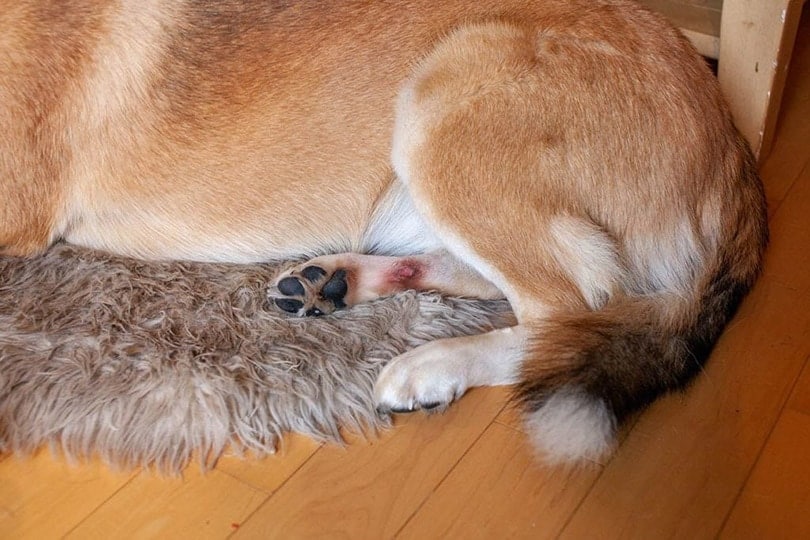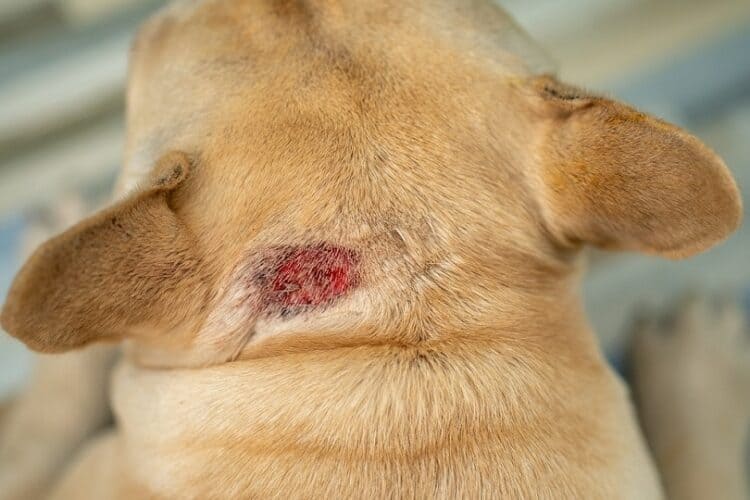Notice an inflamed area on your dog’s body that doesn’t seem to go away? Is the area similar to that of an old scab? Does your dog constantly scratch and sniff the area? Well, chances are that your dog is suffering from what’s known in the vet world as a “hot spot”. Continue reading to learn more about hot spots.
What Are Hot Spots?
Hot spots are a skin infection caused by normal skin bacteria that overruns the dog’s skin’s natural defenses due to damage to its skin. The dog may scratch or chew at the spot to initiate this process–effectively making it worse. Over a period of days or weeks, the area becomes inflamed, itchy, red, and infected.
As a result of bacterial infection, pus oozes out from the dog’s skin. The crust will be tightly adhered to its topcoat and will cause the dog to lose their hair–thus creating the “spot”, which is noticeable.
Hot spots on dogs can quickly grow bigger if they aren’t treated. So, it’s very important to get a diagnosis as soon as you notice the abnormality. Hot spots are way more common in hot and humid weather but can also occur throughout the year, depending on the cause.
What Condition(s) Cause Hot Spots In Dogs?
Hot spots can be caused by a variety of conditions. More specifically, almost any condition that irritates the dog’s skin. This could cause the dog to scratch or chew at the spot constantly, with other contributors including flies, fleas, and other pests being common culprits.
The spots can also be caused by allergies, moist skin, insect bites, matting, and dry skin. Hot spots can be caused by excessive saliva accumulation under the hair coat due to your dog chewing on its skin.
A dog’s saliva contains various enzymes and bacteria that help to keep its mouth and coat clean (which is why they lick themselves). Staphylococcus intermedius is a type of bacteria that can be found in the mouth of dogs. This is the most common type of Staph found in hot spots.
Your dog’s vet may be able to help you determine the root cause by examining the location of hot spots. Hot spots in certain areas can be a symptom of a bigger issue.
For example, hot spots on the hips could be indicative of an anal gland infection, flea infestation, or arthritis. A hotspot near the dog’s eye could also indicate a problem with excessive wax, allergies, nerve irritation, or other issues.

How Do You Treat Your Dog’s Hot Spots?
The first thing you’ll need to do is confirm that the inflamed areas on the dog’s body are in fact hot spots. One of the best ways to do this is to take the dog to the vet. The vet will trim or shave down the infected areas to get a good look at the area and will likely be able to diagnose on the spot.
They also shave it down so that air can get to the infected skin. Next, the vet will remove any dead skin and clean the area. Lastly, they’ll provide an effective antibiotic treatment for your dog, which will likely be in the form of pills, skin creams, or both.
Ways To Prevent Hot Spots
Your best options against future hot spots are to control fleas, properly groom your dog’s skin, and pay attention to areas where its coat may be getting thinner or matted.
Many of the conditions that can trigger hotspots also include skin allergies or ear infections. It’s always best to find and then treat the root cause of hot spots, which is commonly allergies (especially for recurring hot spots).
Give The Dog Daily Supplements
Good vitamin and mineral supplements can help your dog’s skin stay in tip-top condition. For example, a daily dose of fish oil supplements or omega-3 fatty acids can help your dog manage and prevent chronic skin conditions such as hotspots.
They promote healthy skin and have anti-inflammatory properties, which can make your dog more resistant to allergies and infections. You can also give your dog a daily probiotic to reduce common allergies and itchy skin from dryness or fleas.
Daily Activity
Keeping your dog fit and healthy can also help prevent hot spots. For example, if your dog isn’t active and lays around all day, chances are that areas of its topcoat won’t get a sufficient amount of air.
As a result, moisture may develop on its skin, which can lead to irritation, and ultimately hot spots. So be sure that your dog is getting at least anywhere from 15 to 30 minutes of activity each day if it’s in generally good health to do so.
Wrapping Things Up
If you notice any balding areas on your dog’s coat, it’s best to contact your veterinarian as soon as possible. Hot spots can lead to bigger skin issues if not treated quickly and effectively.
If you suspect that your dog has a hotspot, be sure to take it to the vet immediately for confirmation. Once there, the vet will be able to determine if the infected area is a hot spot and will be able to provide treatment accordingly.
Featured Image Credit: Tienuskin, Shutterstock
















